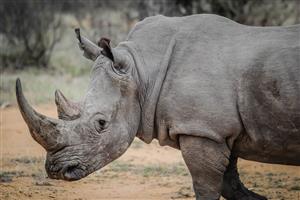
How many animals are born in the world every day?
11/06/2018
Línea Verde
info@lineaverdemunicipal.com
Birds do it, bees do it, even educated fleas do it - well, maybe they don't fall in love but they do procreate, so can we estimate how many animals are born every day across the world?
That was the question posed by a listener to the BBC's More or Less programme, a show which aims to make sense of the numbers that inform our lives.
First things first, what do we mean by the term "animal"? The Oxford English Dictionary defines an animal as "a living organism which feeds on organic matter, typically having specialised sense organs and nervous system and able to respond rapidly to stimuli".
So that's mammals and non-mammals, vertebrates and invertebrates, animals that hatch, and animals that have live births.
To give you some idea of the scale of the question and indeed the answer let's start with a creature that's notorious for its procreation prowess: the rabbit, of Bugs Bunny, Peter and Jessica fame.
Wildlife Britain estimates the breeding population of wild rabbits in the UK is 40 million. In the UK, a rabbit will typically produce up to seven litters each containing three to seven kittens.
If every female wild rabbit in the country had seven litters of, say, five kittens per litter there would be the equivalent of 1,917,808 rabbits born every day.
- Making an entrance in the animal kingdom
- New clues to decline of bees and other pollinators
- BBC Nature: Baby animals
- BBC Nature: Humboldt penguins
So when should we welcome our rabbit overlords? Well sadly - or fortunately depending on your opinion -there is a high mortality rate among rabbit kittens so the majority will not reach maturity. Obviously this is a crude calculation and the real numbers will vary.
But what about less widespread species, like the Humboldt penguin, This creature is native to the coastal regions of Chile and Peru.
Humboldt penguins lay clutches of eggs, generally two at a time and a pair can expect to produce a couple of clutches each year.
Not all of the eggs make it through incubation: but if we look at the figures we have from studying these penguins in captivity and assume the rate is similar in the wild population, we can say that 14,400 Humboldt penguins hatch each year. That averages out at just under 40 Humboldt chicks popping into the world every day.
That isn't many, but the Humboldt penguin is a threatened species, categorised by the International Union for Conservation of Nature, a recognised global authority on such matters, as "vulnerable".
When you compare it to a species that isn't threatened - say a chicken - the numbers are strikingly different.
By extrapolating data collected by the Food and Agriculture Organisation of the United Nations, we can estimate that more than 62 million chickens are born worldwide every day.
That's a lot of chicken. And then there are bees.
It is estimated that during the warmer months of the year the average queen honey bee will lay 1,500 eggs every single day. In January 2018 the National Bee Unit's bee count measured an experimental total of 247,461 honeybee hives in the UK.
So in the summer there could theoretically and with a large degree of luck, be as many as 371,191,500 honey bee hatchlings every day.
None of this seems very accurate does it? Monika Bohm, of London Zoo's Institute of Zoology believes it's an impossible task to purely add up all of the offspring of every species in the world as we just don't know enough about the majority of species' reproductive habits.
However, Prof Axel Rossberg, from Queen Mary's University, believes he might have the answer.
He says that species which weigh a thousandth of another are typically a thousand times more abundant.
Which means that there are more bees than elephants, more woodlice than porcupines and more ants than anteaters.
One of the most abundant animals on the planet is the nematode, which is also known as a roundworm. There are three million nematodes per square metre of land on earth.
One species of nematode that has been studied extensively is called Caenorhabditis Elegans or "C Elegans" to its friends. They lay about five eggs per hour.
By looking at established ratios which allow populations to remain stable, Prof Rossberg estimates that one-in-100 eggs will hatch, giving us a total of 600 quintillion C Elegans nematodes born every day. That's a six followed by 20 zeros.
The maths: three million nematodes per square metre, one nematode lays five eggs per hour, there are 24 hours per day and 1% hatch rate.
When multiplied by the number of square metres of land on earth - which is around about 150,000,000,000,000 - this comes out at 600 quintillion nematodes born per day on land on earth every single day. When the rest of the global nematode population, which lives in water, is taken into account, this figure is much, much, higher.
So there you go. Six hundred quintillion C Elegan nematodes are born every day on land.
And while that's only one animal species, because they're so numerous, the 40 Humboldt penguins, 62 million chickens, rampant rabbits and even the 371,191,500 honey bees pale in comparison, so we can use that as a ballpark estimate for all the animal species as a whole.
There are believed to be around 7.7 million known species of animal on the planet and the National Oceanic and Atmospheric Administration estimates that as much as 95% of the ocean and 99% of the ocean floor has been left unexplored.
So - until we know and have studied all of the species on Earth - this question will remain unsolved.
By Lizzy McNeill. More or Less, BBC Radio 4. BBC News Science & Environmen

Environmental news
- What is COP28 in Dubai and why is it important?
- Climate change: How is my country doing on tackling it?
- COP27: Why the latest UN climate conference matters
- New oil and gas at odds with green goals - report
- World's biggest plant discovered off Australian coast
- Hubble: 'Single star' detected at record-breaking distance
- James Webb telescope parked in observing position
- Brexit paves the way for gene-edited crops
- Venus: Nasa announces two new missions
- Nature: Throwing money at biodiversity schemes is ineffective
- UK woodlands 'at crisis point' amid wildlife decline
- Nasa Mars rover: The clanking sound of Perseverance's wheels
- Climate change: 'Exceptionally hot' 2020 concludes warmest decade
- 'World's ugliest orchid' tops list of new discoveries
- Antarctic place names recognise 'modern explorers'
Cerrar [X]Uso de cookies
Utilizamos cookies propias y de terceros para mejorar nuestros servicios y recopilar datos estadísticos sobre hábitos de navegación. El uso de cookies es necesario para la notificación de incidencias. Si continúa navegando, consideramos que acepta su uso. Puede obtener más información, o bien conocer cómo cambiar la configuración, en nuestra Política de cookies




